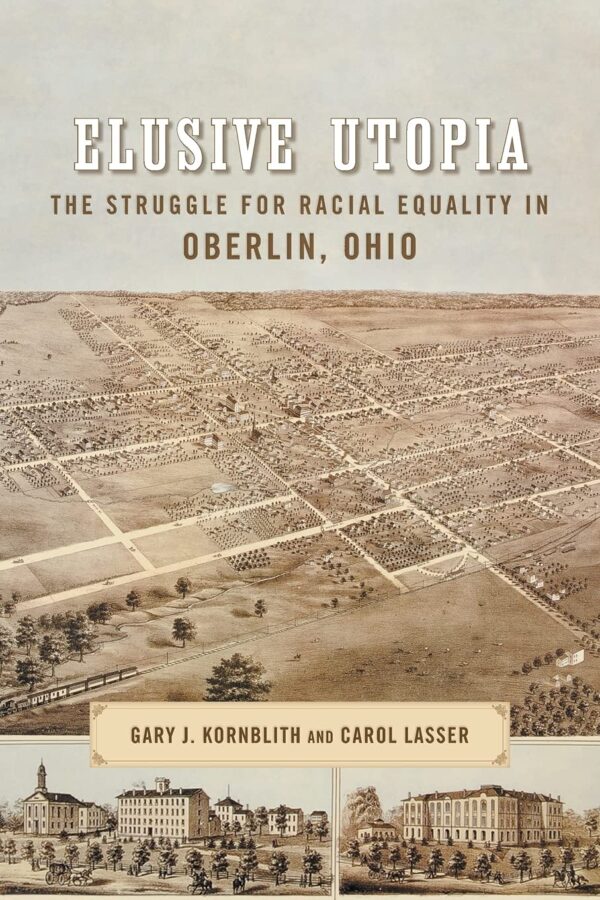Elusive Utopia: The Struggle for Racial Equality in Oberlin, Ohio by Gary J. Kornblith and Carol Lasser. Louisiana State University Press, 2018. Cloth, ISBN: 978-0-80716-956-8. $48.00.
 Racism continues to grip the United States, and many Americans are asking, “why?” The answer requires historical context that traces the nation’s long lineage of racial inequality and examines how pervasive it was—and continues to be—even in locations and institutions specifically created to combat inequality. Elusive Utopia: The Struggle for Racial Equality in Oberlin, Ohio, written by the historians Carol Lasser and Gary J. Kornblith, addresses this question by complicating history’s understanding of Oberlin, Ohio, as a racial utopia; the authors argue that Oberlin failed to realize racial equality.
Racism continues to grip the United States, and many Americans are asking, “why?” The answer requires historical context that traces the nation’s long lineage of racial inequality and examines how pervasive it was—and continues to be—even in locations and institutions specifically created to combat inequality. Elusive Utopia: The Struggle for Racial Equality in Oberlin, Ohio, written by the historians Carol Lasser and Gary J. Kornblith, addresses this question by complicating history’s understanding of Oberlin, Ohio, as a racial utopia; the authors argue that Oberlin failed to realize racial equality.
Oberlin was founded to train white, Christian ministers to rid the American West of “corruption and sin” (2). In 1835, however, the town’s abolitionist founders expanded Oberlin’s mission to include the radical pursuit of racial equality. Opposed to slavery, they believed that egalitarianism could only be attained through religion, manual labor, and education. Oberlin stood apart from other antebellum American towns for its bold mission and its integrated schools and cemeteries; however, after the Civil War ended slavery and Reconstruction recognized Black Americans as citizens (and Black men as voters), Oberlin demonstrated the limits of its egalitarian vision. The community’s unwillingness to uproot less overt but deeply entrenched racism prevented Black Americans from achieving social and economic equality. In the absence of slavery, white residents viewed economic disparity as the result of Black, moral failing—racist views that became as prevalent in Oberlin as they were elsewhere in the country following emancipation. Instead of continuing the fight for racial equality, Oberlin turned to a new battle: temperance.
Organized chronologically, Elusive Utopia’s nine chapters lead the reader from antebellum America through the beginning of the 1920s. Whereas previous studies of Oberlin concluded their examinations shortly after Reconstruction, Lasser and Kornblith contribute to the historiography by concluding their examination “with the advent of legally enforceable residential segregation and the exclusion of people of color from the ranks of the town’s elected officials in the early decades of the twentieth century” (3). The book’s argument draws from an eclectic source base that includes town, county, and state newspapers; reports and minutes of Black and white social organizations conceived in, or directly related to, Oberlin; student records from Oberlin College’s archives; manuscript collections; and most impressively, quantitative data gleaned from census and tax records. Elusive Utopia merges social, gender, political, and economic history while foregrounding the voices of Black and white Oberlinians.
Oberlin’s failed utopia is couched as the result of the community’s departure from its founding principles, yet the authors do not state that members of the community were ever fully united in their ideology and course of action on how to fight inequality. Elusive Utopia points out that from the beginning, the “major element missing from Oberlin’s commitment to racial egalitarianism” was “the involvement of people of color” (32).
Every chapter is woven together with an underlying thread—the internal division within the interracial community, and the respective division that existed within Oberlin’s white and Black communities. For example, disillusionment with the Republican Party for its abandonment of Black advancement and the desire to end partisan politics divided residents. Gideon and Charles Langston had views that stood in stark contrast to other residents. The difference in opinions “reveals the limits of broad generalizations about how Oberlinians ‘saw race’” (75).
Elusive Utopia indicates that the high watermark of the community’s collective commitment to racial justice was the Oberlin-Wellington Rescue in 1858, when the direct action of hundreds of Black and white residents together prevented the re-enslavement of John Price. Armed with knowledge of contradictions that beleaguered Oberlin from the onset, the reader is left to question whether Oberlin truly departed from its founding mission, or if its mission was inherently shortsighted. While the book’s intended focus is the town, and not Oberlin College, its narrative suggests otherwise; the town and the college seem to be inextricably linked at times, making it challenging for the reader to completely untangle the two. Suggestions for further research include how Oberlin publicly celebrated and maintained its radical heritage while concealing its shortcomings.
Elusive Utopia should be regarded as the archetype for well-researched monographs that remain accessible and engaging for a wide readership. Like their previous works, the authors continue to advance our knowledge of the long nineteenth century and the intersectionality of race, gender, and class, providing important historical context for Americans asking similar questions today.
Cassandra Jane Werking is a Ph.D. candidate in the Department of History at the University of Kentucky.
